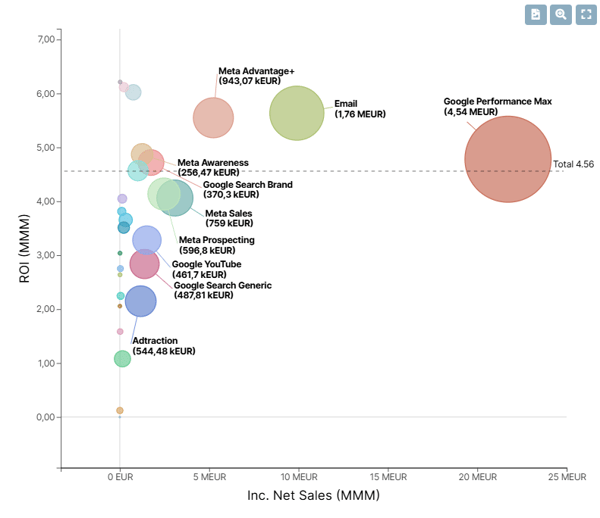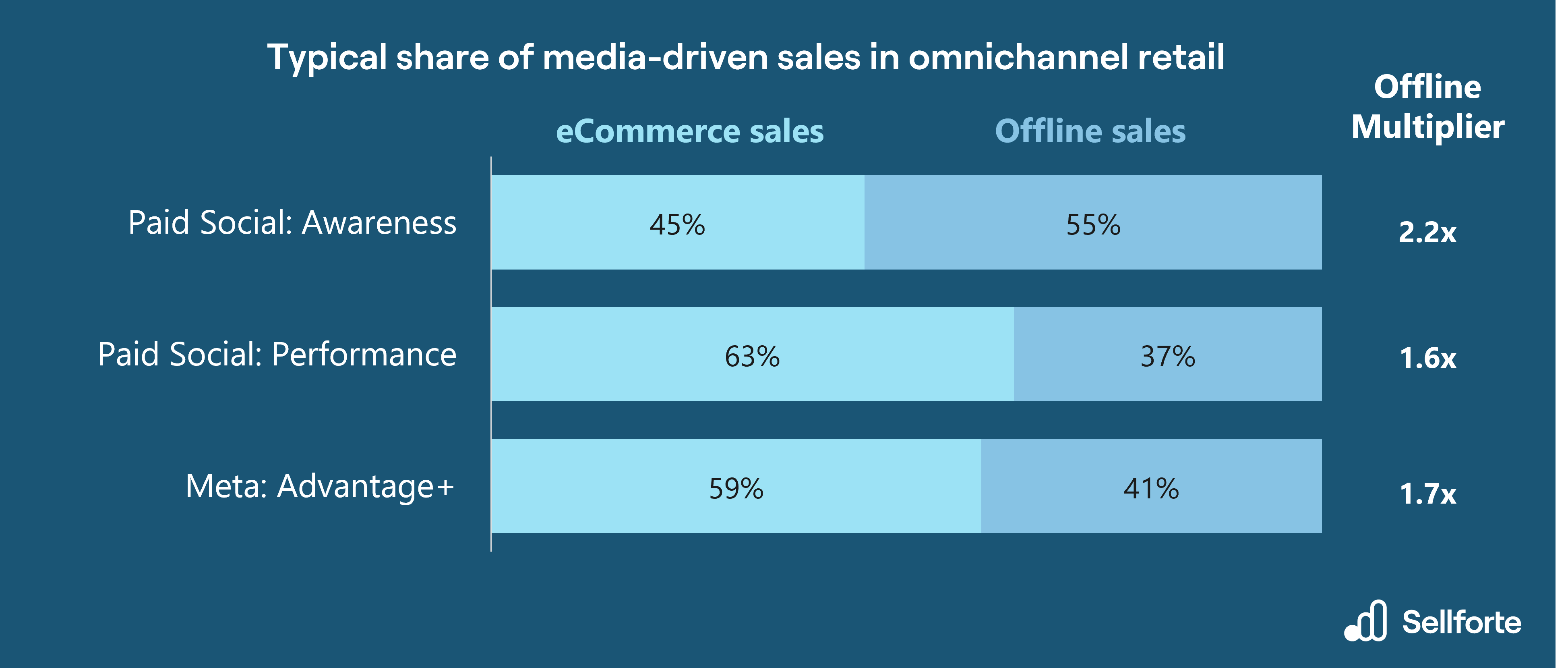11 Benefits of Marketing Mix Modeling (MMM) Every Marketer Should Know
"Why should I start using Marketing Mix Modeling?"
I've answered this question hundreds of times during my 15+ years in marketing measurement. And the answer has changed over the years. Marketing Mix Modeling (MMM) used to be something that marketing teams used once a year in annual planning, evaluating high-level budget scenarios. Nowadays, MMM helps performance marketing teams in tactical campaign optimization.
In this blog, we'll discuss MMM's benefits to marketers in 2025.
1. Measure the True Incremental Sales of Marketing
Let's start with the big one. It's obvious but also the most important:
MMM helps you measure the true incremental sales impact of your marketing efforts.
It helps you understand marketing's actual contribution to your sales, compared to other sales drivers, such as seasonality, promotions or weather. It helps you measure which part of the sales was driven by Google and which part was driven by Meta. Or how much incremental sales was generated by your latest Black Friday campaign.
The concept of incrementality, the idea of measuring marketing's true revenue contribution, sits at the heart of modern measurement. The transition from attribution (such as Last-Click attribution) to Incrementality-based measurement, is the single biggest disruption in marketing measurement of the 2020s.
💡Example: What does Incrementality look like in MMM?
Sales decomposition chart is the most common way to show how marketing, promotions and other factors contribute to sales. Below is an example from Sellforte's public demo, where
- Colors represent incremental sales driven by advertising platforms.
- Dark gray represents Base sales: sales you would get without marketing or promotions.
- Light gray represent promotion-driven sales.

2. Measure the ROI of every Channel and Campaign
When you can measure the true Incremental sales driven by marketing, you can measure marketing's true ROI (Return on Investment). And let's be clear: this is very different from ROAS from Last-Click attribution or Ad Platforms' attribution tools, which are rule-based and not based on incrementality.
Measuring marketing's true ROI enables comparing different activities apples-to-apples: Which marketing activities are actually effective in driving sales for our business?
As an example, I often see marketers positively surprised when they learn how effective their awareness, branding and other top-of-funnel campaigns actually are when they look at MMM-based ROIs for the first time.
Today's MMMs can measure ROI on different levels:
- Media Group: Paid Social, Branded Search, TV, ..
- Media Channel: Paid Social Awareness, Paid Social Prospecting, ...
- Advertising Platform: Meta, Google, TikTok, Pinterest, ..
- Advertising Channel: Meta Awareness, Meta Prospecting
- Campaigns: Meta Black Friday Hats..
- Campaign Objective / Bidding Strategy: Target ROAS, CPC, CPM, ...
💡Example: What does ROI tracking look like in MMM?
While ROI can be visualized in many ways, one common chart is the "bubble chart", which shows the ROI (y-axis), Incremental sales (x-axis) and spend (bubble size). Below is an example from Sellforte's public demo:

3. Understand Saturation Levels
Every media channel saturates at some point, and MMM helps you understand the level of saturation in each channel. Pouring too much on a channel often leads to showing the ads to the same audience multiple times, and there's only so much they can buy.
Saturation can be analyzed with Response Curves, which capture the relationship between incremental sales that a channel is driving and its spend. In the Response Curve example chart below, the channel has lots of room to scale in Point A, but in Point B the channel is highly saturated and additional investments have very little impact on sales.

Marketing Mix Modeling is the only method that can reliably estimate response curves for media. At the same time, Response Curves are highly critical for optimizing media allocation, which is the next topic we will cover.
4. Drive Growth by Optimizing budget Allocation Across Channels
Let's discuss how MMM actually helps you drive revenue growth!
MMM helps you optimize budget allocation across channels, which is the most common optimization use-case of MMM. The benefit comes from re-allocating spend from channels that are more saturated to channels where there's room for scaling.
Based on our research paper, Unlock 6.5% More Sales with Marketing Mix Modeling, optimizing channel allocation is the third biggest optimization lever and typically helps eCommerce businesses increase sales by +1.6% while keeping the same total budget.
💡Example: What does channel-level optimization look like in MMM?
Optimization module of an MMM solution typically has two outputs
- Recommended budget based on some optimization criteria
- Forecast sales for the optimized scenario
Below is an optimization example of the Sellforte's Optimizer shown in Sellforte's public demo:

5. Drive Growth by Optimizing Spend Across Campaigns
Let's get more granular: MMM helps you optimize spend level of each campaign. Campaign optimization means that performance marketing teams get recommended budget and bidding parameter change for each individual campaign, and there can be hundreds of them.
It is very common, that for example many Paid Social campaigns get more spend in MMM-based campaign optimization, as they are under-credited by Last-Click attribution by a factor of 2-9x (check our research: How to measure Meta correctly? GA4 vs. MTA vs. MMM).
Campaign optimization is the largest optimization lever, enabling eCommerce businesses increase their total sales by +2.9% (source: Unlock 6.5% More Sales with Marketing Mix Modeling).
Using MMM to optimize campaign spend is a feature that started emerging in MMM solutions in 2025. Most MMM solutions don't have this feature, because it requires advanced measurement technology that combines MMM, incrementality tests and attribution data.
💡Example: What does campaign spend optimization look like in MMM?
Optimizing campaign spend is a fairly technical task: The performance marketer needs to review and update campaign parameters for each campaign. That's why the most convenient way to show the results are a table, as shown by the Campaign Dashboard in Sellforte's public demo:

6. Drive Growth by Optimizing Budget Pacing
MMM helps marketers optimize their budget pacing, so that media spend is distributed optimally across weeks, preventing for example overinvestment when demand is naturally low and underinvestment when there’s high level of natural demand.
A common pitfall for marketers is to underfund Black Friday campaigns with budget limits, but overinvest in low seasons.
Our research has found that when executed correctly, budget pacing can unlock a +2.0% increase in annual sales for eCom / DTC businesses (source: Unlock 6.5% More Sales with Marketing Mix Modeling).
💡Example: What does budget pacing optimization look like in MMM?
Below is an example from Sellforte's public demo, showing optimal spend for each week:

7. Measure How Marketing Affects Sales in Physical Stores
If you're running an Omnichannel Retail business, you know the frustration: you might be investing 50% of your total budget to digital channels, but you are only measuring how they affect eCommerce sales which might be less than 10% of your total business.
MMM helps your measure how digital channels are driving sales in physical stores, and this can have a significant impact to your measurement.
In a research on Meta and Paid Social more broadly, we found out that offline sales represents 37% - 55% of total sales impact of Paid Social in omnichannel Retail, as summarized by the chart below. This means that you need to multiply Paid Social ROI by 1.6x - 2.2x to capture its full sales impact. The research is available here: How to measure Meta correctly? Part 2: Add offline sales impact.

💡Case Study: Pinterest's offline sales impact for Fashion Retailer C&A
In a case study analyzing Pinterest's incremental sales impact for Fashion Retailer C&A, we found out that more than 60% of Pinterest's total sales impact was in physical store sales. By measuring its full sales impact, C&A was confident in scaling investments to Pinterest further.
8. Measure How Marketing Drives Sales in Amazon (and other marketplaces)
If you're a DTC brand, you're likely selling your products in Amazon and other marketplaces in addition to your own eCommerce store. Optimizing the full sales impact of your marketing requires you to understand how your marketing is affecting in all of your sales channels.
In this case, MMM helps you understand how your marketing efforts are affecting sales in your eCommerce store and marketplaces. In some instances, this is also called the halo effect of marketing.
9. Measure the ROI of offline media
Traditional media channels like TV, radio, print, and outdoor advertising remain important drivers of brand awareness and sales, especially for Retailers, but measuring their effectiveness has always been challenging.
MMM helps you quantify the sales impact of offline media.
This capability ensures that offline media investments are evaluated with the same rigor as digital channels, preventing the common mistake of undervaluing traditional media due to measurement limitations, but also holds traditional channels accountable for their ROI.
10. Future-proof your measurement
Here's the uncomfortable truth: traditional attribution and privacy-invasive measurement methods are dying. With MMM, you're building a measurement foundation that'll work regardless of how the privacy landscape evolves.
11. Secure your career as a CMO or Head of Marketing
This might be the most important point for individual marketers. The industry is moving toward greater accountability and more sophisticated measurement. Marketing leaders who understand and can leverage advanced analytics like MMM, are showing that they deeply care about the business results of the company.
In my experience, marketers who embrace MMM tend to have better relationships with their C-suite peers, are more successful in budget discussions with the finance team, and get more career advancement opportunities.
Summary
The 11 benefits of MMM are
- Measure the true incremental sales of marketing
- Measure the ROI of every channel and campaign
- Understand saturation levels
- Drive growth by optimizing channel allocation
- Drive growth by optimizing spend across campaigns
- Drive growth by optimizing budget pacing
- Measure how marketing drives sales in physical stores
- Measure how marketing drives sales in Amazon and other marketplaces
- Measure the ROI of offline media
- Future-proof your measurement
- Secure your career as a CMO or Head of Marketing
Are You Ready to Start Your MMM journey?
The 11 benefits outlined above represent just the beginning of what's possible with MMM. The question isn't whether your organization needs MMM, it's how quickly you can implement it to start realizing these benefits.
The easiest and fastest way to start your MMM journey is Sellforte's Free Trial. Book your kick-off today!
FAQs
1. What is Marketing Mix Modeling (MMM)?
Marketing Mix Modeling (MMM) is a time-series method for estimating how different media channels drive sales of the company. MMM provides marketers with ROI (Return on Investment) for all channels and campaigns, as well as tools to optimize media budget allocation to increase sales and profits.
Read more about MMM in our guide: What is Marketing Mix Modeling (MMM)? A Complete Guide.
2. What is Incrementality?
Incrementality in marketing refers to the concept of quantifying the actual sales lift originating from investments to media, in contrast to sales driven by other factors, such as seasonality, promotions or organic demand. Incrementality-based measurement provides marketers an estimate how much additional revenue each channel and campaign have been driving.
Learn more about Incrementality in our blog What is Incrementality in Marketing?
3. Why is Marketing Mix Modeling (MMM) better than Last-Click attribution?
Last-Click attribution gives full credit for the conversion to the last advertisement clicked by the user before purchase. This means that it overestimates the effectiveness of bottom-of-funnel channels that are close to purchase, and underestimates top-of-funnel channels and middle-of-funnel channels, such as Paid Social or Paid Video. MMM gives proper credit to each channel across the funnel, based on their performance in driving incremental sales.
Learn more about the shortcomings of Last-Click in our blog The 3 Danger Zones of Last-Click (And How to Avoid Them).
4. Why is Marketing Mix Modeling (MMM) better than Ad Platforms' pixel-based attribution?
Advertising Platforms' attribution methods are not able to distinguish between conversions that would have happened without advertising, conversions that were really driven by other platforms, and conversions that were actually incremental due to advertising on the specific ad platform. MMM is able to measure the true incremental sales of each ad platform.
5. How can I get started with Marketing Mix Modeling (MMM)?
Starting a Free Trial with a top-tier MMM vendor, such as Sellforte, is the easiest way to get started with MMM. Sellforte's Free Trial includes full access to Sellforte's MMM platform for a limited period. It also includes Marketing X-Ray, which is a full performance analysis of your marketing benchmarked to peers. Free Trial scope includes modeling how digital media is driving eCommerce sales. Larger scope is available as a paid trial.
6. What are the steps in taking Marketing Mix Modeling (MMM) into use?
Taking a modern MMM solution in to use includes 3 steps:
Step 1: Connect your data to the MMM platform. This takes 15-30mins for an eCom business, because the data flows directly from the ad platforms and eCommerce platforms. More time is needed for Retailers with offline media.
Step 2: Review the Results after the modeling is done, and define how to adjust your spend allocation based on the results.
Step 3: Start making the first changes, and observe improvements in your sales. Continue building on the success by conducting more optimization actions.
7. How much does Marketing Mix Modeling (MMM) SaaS tools cost?
Pricing of MMM tools is typically dependent on how much media spend you have, because it defines how much improvement can be achieved by optimizing budget allocation. For a price benchmark, you can check Sellforte's pricing page.
8. Which Marketing Mix Modeling (MMM) vendor or tool should I choose?
You should
- Choose an MMM tool that helps you drive more sales
- Choose an MMM Platform That Produces High Quality Results
- Choose an MMM platform that is easy to test & start with
To evaluate these criteria, star a Free Trial with an MMM vendor. If you're a Retailer, eCommerce businesses, or DTC brand, Sellforte is your best choice today for achieving all these criteria. For a complete guide how to choose an MMM tool, check our blog: Ultimate Buyer's Guide to MMM: How to Choose the Best Platform.
9. What are the top Marketing Mix Modeling (MMM) solutions to consider?
Most companies contemplate between using a top-tier MMM SaaS solution, such as Sellforte, and building an in-house MMM solution with Google's Meridian. For a complete comparison between the two, you can check Meridian vs. Sellforte MMM SaaS: The Complete Comparison.
Sellforte is the leading MMM SaaS for Retailers, eCommerce businesses, and DTC brands. If you're in another industry, you might want to review other options from our blog covering top Marketing Mix Modeling companies.
Authors
Lauri Potka is the Chief Operating Officer at Sellforte, with over 15 years of experience in Marketing Mix Modeling, marketing measurement, and media spend optimization. Before joining Sellforte, he worked as a management consultant at the Boston Consulting Group, advising some of the world’s largest advertisers on data-driven marketing optimization. Follow Lauri in LinkedIn, where he is one of the leading voices in MMM and marketing measurement.
You May Also Like
These Related Stories
Tariffs Are Squeezing U.S. eCommerce: 5 Actions Marketers Should Take

